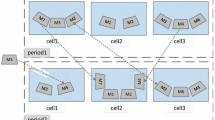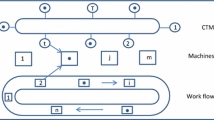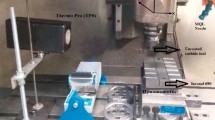Abstract
For a long time, manufacturing industries have been concentrating on increasing productivity by increasing the size of the workforce, but this scenario has changed in last decade since the introduction of the term flexibility. Now, the manufacturers realize that flexibility of the machine environment can provide a better economic solution for improving productivity due to its quick response to the changing environment in the manufacturing industry. However, only very limited research on machine flexibility in the ion plating (IP) industry has been carried out and most of it has focused on product development and quality of coating. The aim of this paper is to determine the optimal level of machine flexibility in an ion plating cell (IPC) to improve the entire system performance. A machine loading sequencing (MLS) model based on a multi-objective genetic algorithm (GA) is developed and the case study of metal finishing company is discussed to validate the proposed model. Different levels of machine flexibility have been assigned to different machines to determine the optimal level to increase the overall system performance based on on-time delivery, quality of product and production cost. The results demonstrated that machine flexibility level in IPC should be zero under recent IP technology. However, when the IP technology is developed enough so that IP machine has the ability to produce different types of coating in high quality, machine flexibility should be introduced to enhance the overall system performance.
Similar content being viewed by others
References
Narain R, Yadav RC, Sarkis J, Cordeiro JJ (2000) The strategic implications of flexibility in manufacturing systems. Int J Agile Manage Systems 2(3):202–213
Petroni A, Bevilacqua M (2002) Identifying manufacturing flexibility best practices in small and medium enterprises. Int J Operat Product Manage 22(8):929–947
Mattox DM (2000) Physical Vapor Deposition (PVD) Processes. Metal Finish 98(1):410–423
Morad N, Zalzala A (1999) Genetic algorithms in integrated process planning and scheduling. J Intell Manuf 10:169–179
Baker KR, Smith JC (2003) A multiple criterion model for machine scheduling. J Sched 6:7–16
Roh HK, Kim YD (1997) Due-date based loading and scheduling methods for a flexible manufacturing system with an automatic tool transporter. Int J Prod Res 35(11):2989–3003
Rahimifard S, Newman ST (2000) Machine loading algorithms for the elimination of tardy jobs in flexible batch machining applications. J Mar Proc Tech 107:450–458
Yi Y, Wang DW (2003) Soft computing for scheduling with batch setup times and earliness-tardiness penalties on parallel machines. J Intell Manuf 14:311–322
Davis L (1985) Job shop scheduling with genetic algorithms. Proceedings of the International Conference on Genetic Algorithms and their Applications, Erlbaum, Hillsdale, NJ, pp 136–149
Artiba A, Elmaghraby SE (1997) The planning and scheduling of production systems: methodologies and applications, Chapman, London
Tiwari MK,Vidyarthi NK (2000) Solving machine loading problems in a flexible manufacturing system using a genetic algorithm based heuristic approach. Int J Prod Res 38:(14)3357–3384
Park BJ, Choi HR, Kim HS (2003) A hybrid genetic algorithm for the job shop scheduling problems. Comput Indus Eng 45:597–613
Jia HZ, Nee AYC, Fuh JYH, Zhang YF (2003) A modified genetic algorithm for distributed scheduling problems. J Intell Manuf 14:351–362
Benjaafar S (1996) Modeling and analysis of machine sharing in manufacturing systems. European J Operat Res 91(1):56–73
Mohamed ZM, Youssef MA, Huq F (2001) The impact of machine flexibility on the performance of flexible manufacturing systems. Int J Operat Product Manage 21(5):707–727
Sheikhzadeh M, Benjaafar S, Gupta D (1998) Machine sharing in manufacturing systems: total flexibility versus chaining. Int J Flex Manuf Sys 10(4):351–378
Author information
Authors and Affiliations
Corresponding author
Rights and permissions
About this article
Cite this article
Chan, F.T.S., Au, K.C., Chan, L.Y. et al. A genetic algorithm approach to machine flexibility problems in an ion plating cell. Int J Adv Manuf Technol 31, 1127–1134 (2007). https://doi.org/10.1007/s00170-005-0299-z
Received:
Accepted:
Published:
Issue Date:
DOI: https://doi.org/10.1007/s00170-005-0299-z




